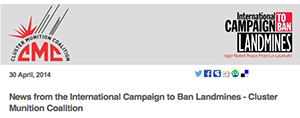Use of cluster bombs
Cluster munitions have been used by over 20 states during armed conflict in over 35 countries.
From March 2015 to February 2017, the armed coalition led by Saudi Arabia used cluster munitions in air strikes against Houthi forces in Yemen. The coalition is comprised of Bahrain, Egypt, Jordan, Kuwait, Morocco, Qatar, Sudan, and the United Arab Emirates. Use of cluster munitions likely continued in 2017 and 2018, although first-hand evidence was increasingly hard to collect and no attacks could be fully confirmed by the Cluster Munition Monitor.
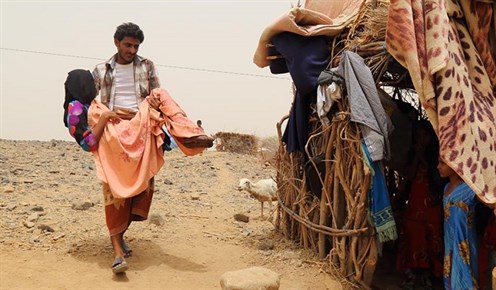
Fatima Ibrahim al-Marzuqi is being carried by her brother because she is not able to walk due to her injuries sustained during a cluster munition attack on Malus village on 7 June 2015.
© 2015 Ole Solvang/Human Rights Watch
Cluster Munition Coalition Call
- The Saudi-led coalition must stop using cluster munitions immediately.
- Cluster munition remnants must be cleared and destroyed as soon as it is safe to do so.
- Through risk education, clear warnings must be given to communities about the terrible danger unexploded bomblets pose.
- The victims of cluster munitions and other explosive weapons must be supported.
- Saudi Arabia, Bahrain, Egypt, Jordan, Kuwait, Morocco, Qatar, Sudan and the United Arab Emirates should join the Convention on Cluster Munitions without further delay.
- States Parties to the Convention on Cluster Munitions should continue to condemn use of cluster munitions in Yemen and call on Saudi Arabia and members of the coalition to join the Convention.
------- Update July 2018 ---------
The Cluster Munition Monitor did not find evidence of cluster munition use in the first half of 2018.
Reports by the ACLED found evidence of possible cluster munition use in Saada in 2017, but international organizations and the media were unable to access the north of Yemen where the attacks were reported. The Cluster Munition Monitor could not independently confirm the attacks.
------- Update March 2017 -------
Cluster munitions made in Brazil continue to kill and harm civilians in Saada.
This article summarizes what is known after two years of cluster munition use by the Saudi-led armed coalition in Yemen.
------- Update December 2016 -------
On 19 December 2016, following many months of intense pressure by civil society in the United Kingdom, Saudi Arabia announced it stopped using cluster munitions made in the United Kingdom.
In December 2016, an attack with Brazil-made cluster munitions kills civilians in Saada.
------- Update June 2016 -------
On 27 May 2016, the United States suspended any transfers of cluster munitions to Saudi Arabia, in the wake of harm caused to civilians in Yemen.
On 23 May 2016, Amnesty International released research findings confirming that cluster munitions made in the United Kingdom in the 1970s were used in Yemen. In the days that followed, two UK ministers claimed, despite clear evidence to the contrary, that no UK-supplied cluster munitions had been used in the Yemen conflict.
------- Update January 2016 -------
Saudi-led coalition strikes Yemen's capital with cluster bombs
On 6 January 2016, Saudi Arabia-led coalition forces dropped cluster bombs on residential neighborhoods in Sanaa, Yemen’s capital city, reported Human Rights Watch. While civilian casualties have not yet been identified, the use of cluster bombs, an inherently indiscriminate weapon, in populated areas is a clear violation of international humanitarian law.
“Cluster bombs have been banned by 118 countries because they cannot discriminate between civilian and military targets,” said Megan Burke, Director of the Cluster Munition Coalition. “The use of cluster bombs in a densely populated area such as Sanaa shows complete disregard for human life. All members of the Saudi-led coalition should cease all use of cluster munitions and should be held accountable for war crimes associated with their use.”
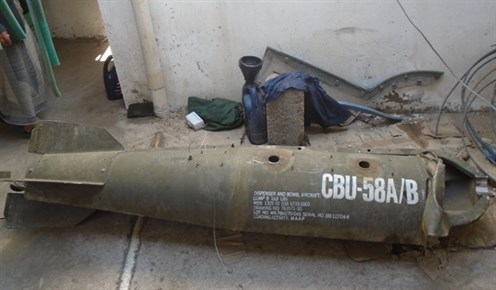
Cluster bomb (CBU-58A/B) in AL Judairi Police Station, Sana'a, 6 January 2016, © OHCHR Yemen Country Office.
Human Rights Watch, a founding member of the Cluster Munition Coalition, collected evidence of at least two aerial cluster bomb attacks in two different Sanaa neighborhoods on 6 January; a third attack, on Sanaa’s al-Thiaba neighborhood, was widely reported by social media but has not yet been confirmed.
Cluster munitions used in the attacks have been identified as US-made BLU-63 antipersonnel/anti-materiel submunitions and components of a CBU-58 cluster bomb. Each air-dropped CBU-58 cluster bomb contains 650 submunitions. Cluster munitions of this type were exported by the United States to Saudi Arabia between 1970 and 1995.
“As a party to the conflict in Yemen, the United States must also be held responsible for any war crimes in which its forces took part,” said Burke. “It must investigate this most recent and egregious use of weapons that have been outlawed by 118 countries through the Convention on Cluster Munitions.”
Since the start of the Saudi-led strikes on Yemen on 26 March 2015, cluster munition use has been documented on several occasions and, despite initial denials of any plans to use cluster bombs, the Saudis have admitted to their use. Civilian casualties were documented as a result of cluster munition strikes carried out between April and August. On 6 January 2016, the Office of the UN High Commissioner for Human Rights (OHCHR) issued a report sharing the evidence they have collected of strikes on several villages in Hajjah governorate. The 6 January strikes were the first identified on Sanaa, Yemen’s capital city. Both Human Rights Watch and OHCHR have collected photo evidence of the cluster bomb attack on Sanaa.
The Convention on Cluster Munitions bans all use, production, sale and transfer of cluster munitions. The Cluster Munition Coalition calls on all members of the Saudi-led coalition to stop all use of cluster munitions and join the Convention without further delay.
The Cluster Munition Coalition has sent a letter condemning these strikes and calling on Saudi Arabia to cease all use and join the Convention.
The Cluster Munition Coalition has also sent a letter urging the U.S. to demand that Saudi-led coalition members stop using cluster munitions. The letter also asks the U.S. to investigate its own role in the recent strikes and to cooperate with any independent, international inquiry into alleged violations of the laws of war by all sides.
--------
Cluster Bombs Wound Civilians in Yemen
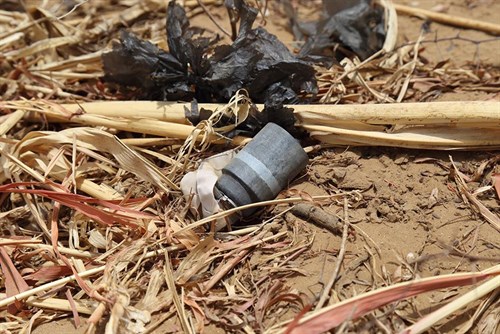
An unexploded M77 DPICM submunition found in Dughayj village, northern Yemen, after a cluster munition attack in June or July 2015.© 2015 Ole Solvang/Human Rights Watch
Geneva, 31 May 2015 -- Despite indicating that "We are not using cluster bombs at all," the coalition led by Saudi Arabia is using cluster bombs in Yemen. Human Rights Watch has started to document civilian victims, including a child. The Cluster Munition Coalition calls on all parties to the conflict to make an official public commitment never to use cluster bombs.
Cluster bombs are indiscriminate weapons that are imprecise at the time of use and leave behind submunitions that remain a threat for anyone in the area long after use. While none of the states that comprise the Saudi Arabia-led coalition are parties to the 2008 Convention on Cluster Munitions, they must all respect the principles of distinction and proportionality established by International Humanitarian Law.
"The Cluster Munition Coalition condemns the use of cluster munitions in Yemen and calls on all parties to ensure no future use," said Megan Burke, Director of the Cluster Munition Coalition.
In two incidents documented by Human Rights Watch (27 April, 23 May), cluster bombs were air-dropped, which clearly points responsibility to the Saudi-led coalition, since it is the only party using aircraft. In another incident (29 April), cluster bombs were fired from the ground. While both sides could have been capable of firing the type of submunition employed, the incident took place in an area that had been under attack by the Saudi-led coalition, and within range of Saudi artillery, pointing again responsibility to the coalition.* Information has also been received that suggests other possible instances of use of cluster bombs.
A number of civilians were wounded in the attacks or when submunitions exploded after use. In one particular incident, four civilians were wounded, including a ten-year-old boy, when "bombs that looked like toys" exploded when picked up from the ground.
Human Rights Watch further noted that the types of cluster bombs used recently in Yemen include BLU-97, supplied by the United States in the early 1990s.
The Saudi Arabia-led coalition comprises Bahrain, Egypt, Jordan, Kuwait, Morocco, Qatar, Sudan and the United Arab Emirates. The United States provides logistics and intelligence support.
Cluster bombs were also used in Yemen by the Saudi-led coalition earlier in April 2015. There is credible evidence that Saudi Arabia had previously used cluster bombs in air strikes on Yemen's northern Sada'a governorate, in November 2009.
* The Houthis could have fired a weapon that malfunctioned and landed in their own territory, preventing Human Rights Watch from conclusively establishing responsibility for the attack.
-----
States and opinion leaders reactions in 2015 and early 2016
The Netherlands, President of the Convention on Cluster Munitions in 2016, expresses concern over the use of cluster munitions in Yemen and calls on all countries in the coalition and the Yemeni government to react to these allegations in a concrete, open and transparent way, 12 January 2016.
UN Secretary-General Ban Ki-moon expresses concerns and warns that the use of cluster bombs in Yemen could be a war crime, 8 January 2016.
Costa Rica, President of the Convention on Cluster Munitions, condemns use of cluster munitions in Yemen: Costa Rica condena el uso de municiones en racimo en Yemen, 5 May 2015.
Croatia, President of the Convention on Cluster Munitions in 2015, is sad and dismayed by the news of cluster munition use in Yemen, calls on states to choose the right side of history.
Queen Noor of Jordan says use of cluster munitions would be a terrible sin.
United States' Department of State says in 2015 it is looking into those details carefully.
Norway condemns use of cluster munitions in Yemen, calls on more states to join the Convention on Cluster Munitions.
Infographics
Stockpilers and suppliers of cluster bombs used in Yemen (JPG & PDF)
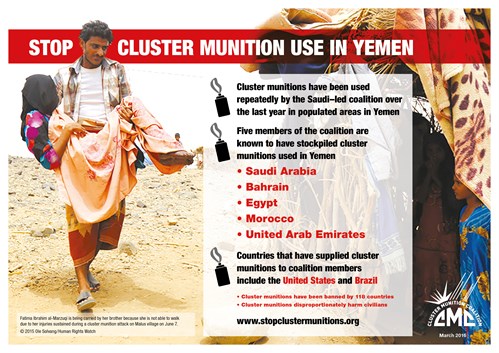
Casualties by cluster bombs use in Yemen (JPG & PDF).
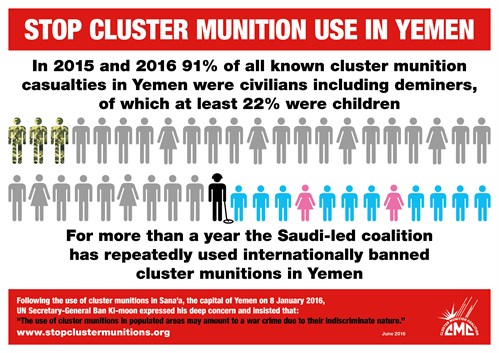
More
Yemen: Coalition Drops Cluster Bombs in Capital (Human Rights Watch, 7 January 2016).
UNHCHR Press Briefing Notes on Yemen (UN High Commissioner for Human Rights, 5 January 2016).
Yemen bombarded with cluster munitions (CMC, 4 May 2015).
Use of cluster bombs in Yemen in April 2015, Media Articles (New York Times, Financial Times, Ria Novosti, etc.)
The Landmine and Cluster Munition Monitor report on Yemen.


